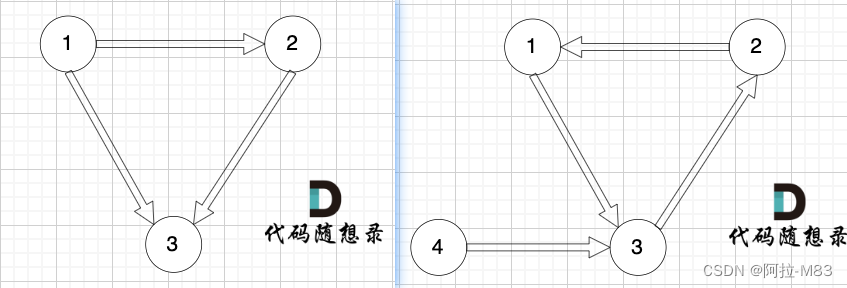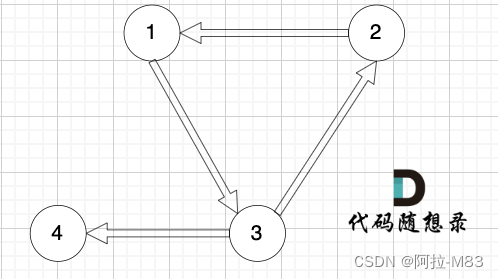热门标签
热门文章
- 1JQuery 入门 - 附案例代码_jquery前端开发实战教程案例源码(1)_jquery项目实战
- 2Python程序设计之 —— 简易学生信息管理系统_用python做信息管理系统_基于python管理系统
- 3利用Python实现邮件发送_python发邮件
- 4一个悄然崛起的国产开源项目
- 5jquery赋值_jquery发布新版修复严重漏洞,请立即升级!
- 6清华大学刘知远:知识指导的自然语言处理
- 7基于Spring Boot的网上商城购物系统_基于springboot的购物商城
- 8完美解决conda命令出现CondaHTTPError: HTTP 000 CONNECTION FAILED for url报错的终极方法_连不上conda服务器
- 9termux+cpolar+codeserver 自启动 打造远程开发环境_termux vscode server
- 10【通俗易懂区块链】PoS(Proof of Stake)权益证明_通俗易pos
当前位置: article > 正文
代码随想录Day70(图论Part06)
作者:weixin_40725706 | 2024-07-10 05:04:55
赞
踩
代码随想录Day70(图论Part06)
108.冗余连接
思路:每次更新输出的边,来保证删除的是输入中最后出现的那条边。关键是,我要知道哪条边可以删除,而且是在join的时候就判断
尝试(难得AC)
- import java.util.Scanner;
-
- public class Main {
- private static int[] father;
- private static int s1 =0;
- private static int t1 =0;
- public static void main(String[] args) {
- Scanner scanner = new Scanner(System.in);
-
- int n = scanner.nextInt(); // 节点数量
-
- // 初始化并查集
- father = new int[n + 1];
- init(n);
-
-
- // 读取边并构建并查集
- for (int i = 0; i < n; i++) {
- int s = scanner.nextInt();
- int t = scanner.nextInt();
- join(s, t);
- }
- System.out.println(s1+" "+t1);
-
-
- }
-
- // 并查集初始化
- private static void init(int n) {
- for (int i = 1; i <= n; i++) {
- father[i] = i;
- }
- }
-
- // 并查集里寻根的过程
- private static int find(int u) {
- if (u != father[u]) {
- father[u] = find(father[u]);
- }
- return father[u];
- }
-
- // 判断 u 和 v 是否找到同一个根
- private static boolean isSame(int u, int v) {
- return find(u) == find(v);
- }
-
- // 将 v -> u 这条边加入并查集
- private static void join(int u, int v) {
- int rootU = find(u);
- int rootV = find(v);
- if (rootU != rootV) {
- father[rootV] = rootU;
- }else{
- s1 = u;
- t1 = v;
- }
- }
- }

小结
基于【寻找存在的路径】代码改造,如果发现输入的(s,t)指向同一个根,说明是冗余连接,通过s1,t1每次join的时候更新
109.冗余连接||
题目:109. 冗余连接II (kamacoder.com)
思路:按照题目的意思,至少有一条边是可以删除的,我想通过fa数组,找到fa中最少被指向的元素,删掉该边,或者是说,输出该边
在遍历father数组时,还需要记录是哪条边,或许可以用set来存储
尝试(标题4)
- import java.util.*;
-
- class Main {
- public static int[] father;
- public static void main(String[] args) {
- Scanner scanner = new Scanner(System.in);
- int n = scanner.nextInt();
-
- father = new int[n + 1];
- init(n);
-
- for (int i = 0; i < n; i++) { // 修正循环范围
- int s = scanner.nextInt();
- int t = scanner.nextInt();
- join(s, t);
- }
-
- int[] count = new int[n + 1];
- Map<Integer, Integer> map = new HashMap<>(); // 使用 Map
-
- for (int i = 1; i <= n; i++) { // 修正循环范围
- int root = find(i); // 确保父节点是根节点
- count[root]++;
- map.put(i, root);
- }
-
- for (int i = 1; i <= n; i++) { // 修正循环范围
- if (count[i] == 1) {
- System.out.println(map.get(i) + " " + i);
- }
- }
- }
-
- public static void init(int n) {
- for (int i = 1; i <= n; i++) {
- father[i] = i;
- }
- }
-
- public static int find(int u) {
- if (u != father[u]) {
- father[u] = find(father[u]);
- }
- return father[u];
- }
-
- public static void join(int u, int v) {
- int rootU = find(u);
- int rootV = find(v);
- if (rootU != rootV) {
- father[rootU] = rootV;
- }
- }
- }

答案
- import java.util.*;
-
- public class Main {
- public static int n;
- public static int[] father;
- public static int[] inDegree;
-
- public static void main(String[] args) {
- Scanner scanner = new Scanner(System.in);
- n = scanner.nextInt();
-
- father = new int[n + 1];
- inDegree = new int[n + 1];
-
- List<int[]> edges = new ArrayList<>();
- for (int i = 0; i < n; i++) {
- int s = scanner.nextInt();
- int t = scanner.nextInt();
- inDegree[t]++;
- edges.add(new int[]{s, t});
- }
-
- List<Integer> vec = new ArrayList<>(); // 记录入度为2的边(如果有的话就两条边)
- // 找入度为2的节点所对应的边,注意要倒序,因为优先删除最后出现的一条边
- for (int i = n - 1; i >= 0; i--) {
- if (inDegree[edges.get(i)[1]] == 2) {
- vec.add(i);
- }
- }
- if (!vec.isEmpty()) {
- // 放在vec里的边已经按照倒序放的,所以这里就优先删vec.get(0)这条边
- if (isTreeAfterRemoveEdge(edges, vec.get(0))) {
- System.out.println(edges.get(vec.get(0))[0] + " " + edges.get(vec.get(0))[1]);
- } else {
- System.out.println(edges.get(vec.get(1))[0] + " " + edges.get(vec.get(1))[1]);
- }
- return;
- }
-
- // 处理情况三
- // 明确没有入度为2的情况,那么一定有有向环,找到构成环的边返回就可以了
- getRemoveEdge(edges);
- }
-
- // 并查集初始化
- public static void init() {
- for (int i = 1; i <= n; ++i) {
- father[i] = i;
- }
- }
-
- // 并查集里寻根的过程
- public static int find(int u) {
- return u == father[u] ? u : (father[u] = find(father[u]));
- }
-
- // 将v->u 这条边加入并查集
- public static void join(int u, int v) {
- u = find(u);
- v = find(v);
- if (u == v) return;
- father[v] = u;
- }
-
- // 判断 u 和 v是否找到同一个根
- public static boolean same(int u, int v) {
- u = find(u);
- v = find(v);
- return u == v;
- }
-
- // 在有向图里找到删除的那条边,使其变成树
- public static void getRemoveEdge(List<int[]> edges) {
- init(); // 初始化并查集
- for (int i = 0; i < n; i++) { // 遍历所有的边
- if (same(edges.get(i)[0], edges.get(i)[1])) { // 构成有向环了,就是要删除的边
- System.out.println(edges.get(i)[0] + " " + edges.get(i)[1]);
- return;
- } else {
- join(edges.get(i)[0], edges.get(i)[1]);
- }
- }
- }
-
- // 删一条边之后判断是不是树
- public static boolean isTreeAfterRemoveEdge(List<int[]> edges, int deleteEdge) {
- init(); // 初始化并查集
- for (int i = 0; i < n; i++) {
- if (i == deleteEdge) continue;
- if (same(edges.get(i)[0], edges.get(i)[1])) { // 构成有向环了,一定不是树
- return false;
- }
- join(edges.get(i)[0], edges.get(i)[1]);
- }
- return true;
- }
- }

小结
要考虑的情况有三种
- 有入度为2的节点
- 删除前,先判断删除后,本图能否成为有向树
- 删哪个都可以时,就选择顺序靠后的删除

- 没有入度为2的节点
- 图中有环,删掉构成环的边

声明:本文内容由网友自发贡献,不代表【wpsshop博客】立场,版权归原作者所有,本站不承担相应法律责任。如您发现有侵权的内容,请联系我们。转载请注明出处:https://www.wpsshop.cn/w/weixin_40725706/article/detail/804916
推荐阅读
相关标签


